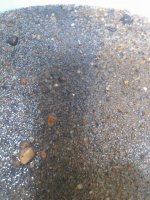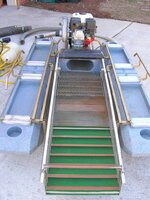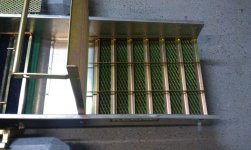Jason in Enid
Gold Member
- Oct 10, 2009
- 9,581
- 9,201
- Primary Interest:
- All Treasure Hunting
This was my first time dredging in fast water! I have been in fast water before, but I always picked spots where the current was slacked. BOY IS IT DIFFERENT! It was also frustrating! My hands and arms are killing me, I've never moved so many rocks in my life. I also never expected the water to behave the way it did.
I started close to shore , made my hole and then worked it out into the current. I could never get more than 4 - 5 feet deep. It was all loose flood material. a 4 foot deep hole needed to be about 10 feet across to be stable. As I worked my hole down, the water pressure kept curling down the down-stream boulders, blasting the sands down the slope to my nozzle. This meant I was spending more time just sucking and less time actually gaining depth. It also meant that it was stripping away everything holding the bolder slope in place. So I sucked for half and hour, gained 6 inches in depth and then the hole collapsed. Spend time heaving rocks out of my hole and keep working down and out. repeat for 2 days. The last collapse was so bad I just called it quits a couple hours early. It would have taken me the rest of my time just to clear it out away.
I have never seen so much black sand. I shot some video but I havent looked at it to see if it shows up or not.
I started close to shore , made my hole and then worked it out into the current. I could never get more than 4 - 5 feet deep. It was all loose flood material. a 4 foot deep hole needed to be about 10 feet across to be stable. As I worked my hole down, the water pressure kept curling down the down-stream boulders, blasting the sands down the slope to my nozzle. This meant I was spending more time just sucking and less time actually gaining depth. It also meant that it was stripping away everything holding the bolder slope in place. So I sucked for half and hour, gained 6 inches in depth and then the hole collapsed. Spend time heaving rocks out of my hole and keep working down and out. repeat for 2 days. The last collapse was so bad I just called it quits a couple hours early. It would have taken me the rest of my time just to clear it out away.
I have never seen so much black sand. I shot some video but I havent looked at it to see if it shows up or not.


 as 100lb on the small of your back is a tough one.John
as 100lb on the small of your back is a tough one.John


 I'm starting to think some of yall crossed the line of sanity in search for gold!
I'm starting to think some of yall crossed the line of sanity in search for gold! 





